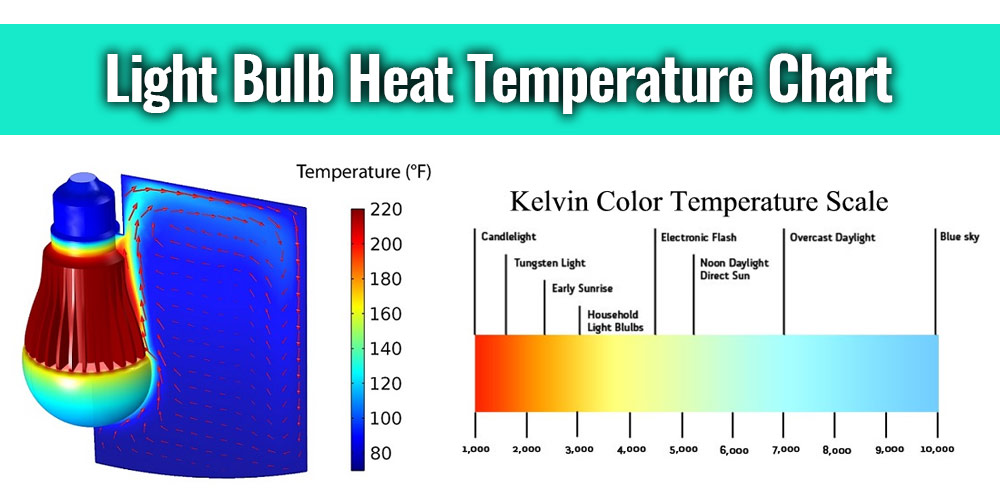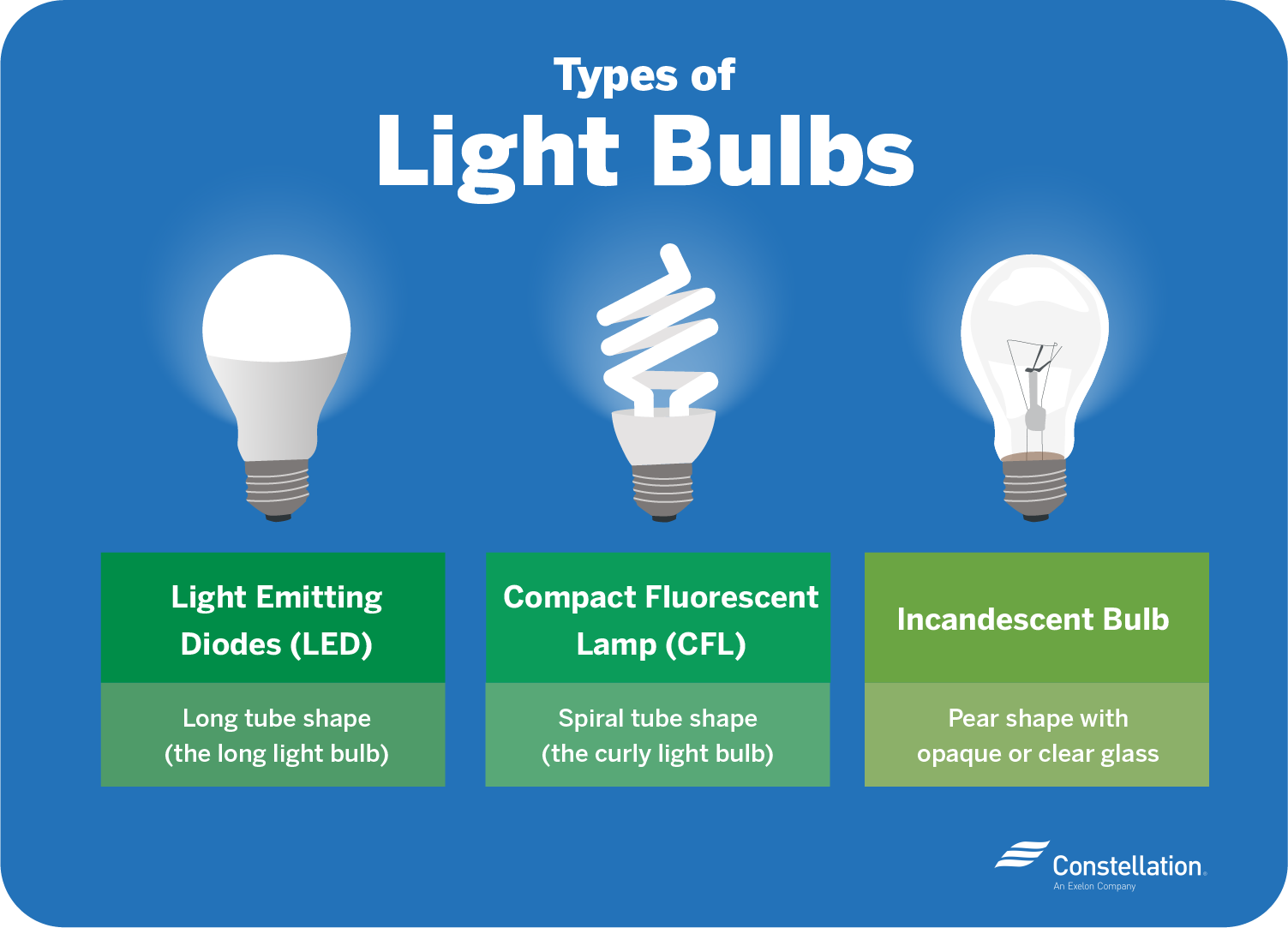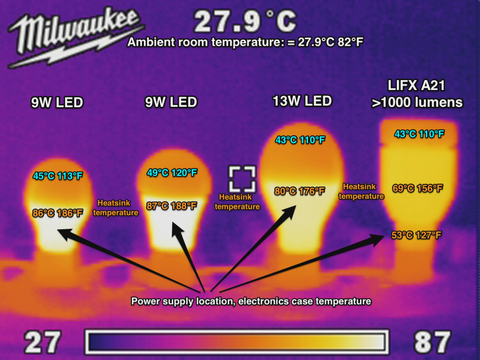Which Light Bulbs Produce The Most Heat
Although the bulbs produce the same kind of light lumens-brightness the incandescent bulb produces more heat and uses more energy. There are two primary kinds of heat lamps red lamps and frostedclear lamps.
 Light Bulb Heat Temperature Chart Razorlux Lighting
Light Bulb Heat Temperature Chart Razorlux Lighting
Heat produced from light bulbs.

Which light bulbs produce the most heat. However when the visible light strikes and is absorbed by other objects it is converted to heat. 200W LED Flood Light. That means is directly produces less infrared energy heat.
The more energy Watts run through the wire filament the more light lumens is produced. Incandescent bulbs are the cheapest lighting option if you only consider upfront costs. Contrary to some marketing claims LED bulbs do indeed generate heat as does anything that consumes electricity.
We offer products from the largest manufacturers like Sylvania Philips and GE. What are you waiting for. They both produce 100 watts of heat.
Because incandescent and halogen bulbs create light through heat about 90 of the energy used is wasted to generate heat. In other words it produces about 2 watts of light and 98 watts of heat. A 100-watt incandescent light bulb has a filament temperature of approximately 4600 degrees Fahrenheit.
Secondly how hot does a 60 watt light bulb get. Which produces more heat. Normal light bulbs are designed to produce light and the heat they generate is considered to be waste.
This creates more radiant heat and allows the heat lamp to be much more useful as a source of warmth than a regular lamp. More energy used also means more heat is produced. The heat makes the filament white-hot producing the light that you see.
The incandescent bulb or bulbs in the lamp produce heat by generating infrared light. Combustion offers another way to produce photons. A 100W LED bulb or a 100W incandescent.
Drawbacks of Incandescent Lighting. Unlike old light bulbs incandescent and CFLs LED lights dont require a filament or fluorescent gas to produce light. To reduce the heat emitted by regular incandescent and halogen bulbs use a lower watt bulb like 60 watts instead of 100.
An incandescent bulb emits light through the heating of a small metallic coil called a filament surrounded by gases that heat to approximately 4000 F. They possess very different propertiesincandescent bulbs rely upon metals gas and heat while CFLs rely more upon a reaction between the internal and outside materials. So in that respect both.
Incandescent light bulbs create light by heating a filament inside the bulb. The important thing to keep in mind is that LEDs consume a lot less energy than incandescent or halogen bulbs and are much more efficient in how they use that energy versus traditional bulb types. We can easily state and confirm that LEDs by far are the most efficient light bulbs in term of heat production and even price.
The next hassle right now is to know how to pick the right LED light bulb out of the numerous products out there. Halogen light bulbs create light through the same method. The Environmental Protection Agency studies indicate the fluorescent bulb saves 6 per year in electricity costs and up to 135 over five years.
Hence they dont produce any heat when lit thanks to the built-in heat sink that absorbs radiated heat to keep energy consumption and heat dissipation low. Notice that I didnt say 100W equivalent LED Heres where the trick is. In fact a typical light bulb produces perhaps 15 lumens per watt of input power compared to a fluorescent bulb which produces between 50 and 100 lumens per watt.
For these reasons incandescent lights emit more heat energy than CFLs. These are the most common type of light bulbs found in stores and most homes. Heat lamps operate on the same principles as regular incandescent lamps but produce much more infrared radiation.
Incandescent light bulbs burn much hotter than compact fluorescent light bulbs do. According to the Wikipedia online encyclopaedia a 100 watt bulb is 21 efficient. The 100W LED lamp puts out more visible light than the 100W incandescent.
The surface temperature of incandescent light bulbs varies from 150 to more than 250 degrees whereas compact fluorescent light bulbs have a surface temperature of 100 degrees Fahrenheit. Incandescent light bulbs produce light by heating a wire the tungsten filament to a high temperature by running an electric current through it until it glows brightly. A halogen lamp is a bit better.
An incandescent lamp is an extremely inefficient light source. Most of the energy that goes into an incandescent bulb is lost as heat. Because incandescent and halogen bulbs create light through heat about 90 of the energy used is wasted to generate heat.
Incandescent bulbs produce the most heat for a given amount of light. You are now set and ready to start lighting the dark. Only 10 percent of the energy is used to create light the other 90 percent becomes heat.
Conversely the light bulbs that are used in heat lamps are intended primarily to produce heat with the light being essentially a waste product. This is true whether the bulb is clear or colored glass. While providing plenty of light they release 90 of their energy as heat making them fairly inefficient in comparison to compact fluorescent lamp bulbs.
Fluorescent lights produce much less heat and LED produces the least. Halogen incandescent light bulbs are widely available and come in a wide variety of shapes sizes and warmths making them convenient to replace. Halogen and incandescent light bulbs create light from electric current heating a metal filament inside the bulb.
Fluorescent light bulbs use an entirely different method to create light.
 What Kind Of Light Bulb Doesn T Produce Heat Quora
What Kind Of Light Bulb Doesn T Produce Heat Quora
 Led Vs Cfl Bulbs Which Is More Energy Efficient
Led Vs Cfl Bulbs Which Is More Energy Efficient
 What Is Light Bulb Heat Temperature Chart How Hot Can A Light Bulb Be
What Is Light Bulb Heat Temperature Chart How Hot Can A Light Bulb Be
 How Hot Are Led Light Bulbs Lifx Australia
How Hot Are Led Light Bulbs Lifx Australia